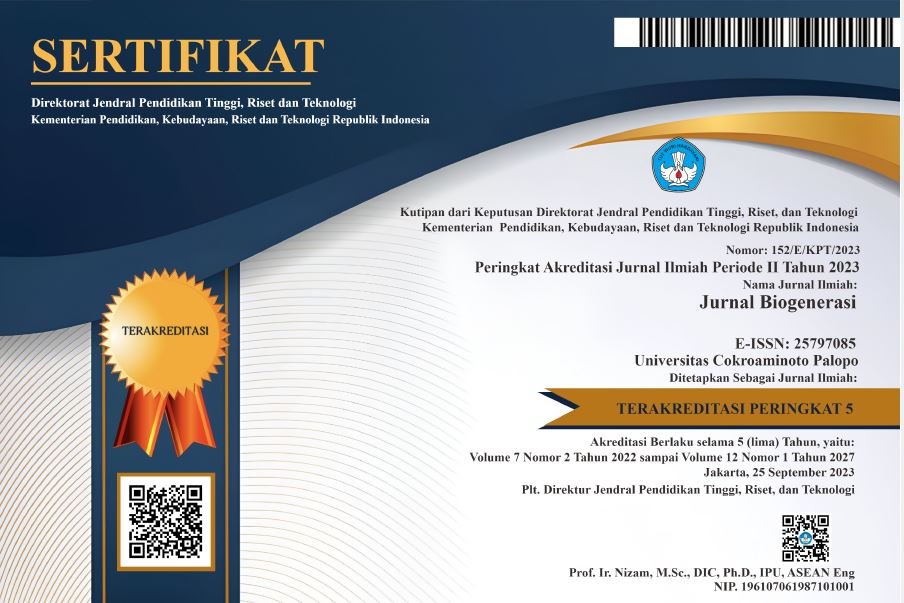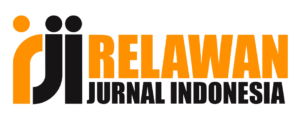PROFIL KETERAMPILAN PEMECAHAN MASALAH SISWA SMA NEGERI 1 WONOMULYO PADA MATA PELAJARAN BIOLOGI DI MASA PANDEMI COVID-19
DOI:
https://doi.org/10.30605/biogenerasi.v7i2.1876Keywords:
Problem Solving Skills, Biology Learning, High School State 1 WonomulyoAbstract
This research to describe problem solving skills on the biology subject of SMA Negeri 1 Wonomulyo students during the pandemic Covid-19. Descriptive research with this survey method uses the sampling is simple random sampling. Research subjects in research these are students of class X MIPA which consists of 5 classes and each class represented by 11 people, so the research subjects amounted to 55 people. Collecting data in this study using skills test questions essay problem solving, structured interview with eye teacher biology lessons and documentation of lesson plans and questions used by teachers which aims to serve as information supporting research results. Result data the study was analyzed using descriptive statistical analysis for describe students' problem solving skills, as well as analysis using the excel program to calculate the average of each indicator problem solving skills . The results showed that the four indicator of problem solving skills the highest percentage obtained indicator planning problem solving 60.45%; and lowest percentage indicator that is solving the problem 32.95%. Overall skill problem solving for SMA Negeri 1 Wonomulyo students is in the less category with an average of 48.52
Downloads
References
Arikunto, S. (2010). Prosedur Penelitian Suatu Pendekatan Praktik. Yogyakarta: Rineka Cipta.
Buana, P. S. L. (2017). Penggunaan Model Discovery Learning untuk Meningkatkan Hasil Belajar dan Percaya Diri Siswa pada Subtema Wujud Benda dan Cirinya (Penelitian Tindakan Kelas di Kelas V SDN Gentra Masekdas Bandung Tahun Pelajaran 2017/2018). Universitas Pasundan Bandung. Bandung: Skripsi
Handayani, K. (2017). Analisis Faktor–Faktor yang Mempengaruhi Kemampuan Pemecahan Masalah Soal Cerita Matematika. Semnastikaunimed 1(2).
Hanifa, N. I., Akbar, B., Abdullah, S., & Susilo. 2019. Analisis kemampuan memecahkan masalah siswa kelas x ipa pada materi perubahan lingkungan dan faktor yang mempengaruhinya. Jurnal Penelitian Pendidikan Biologi, 121–128
Hart, D. 1994. Authentic assesment (M. Kane (ed.)). Addison-Wesley Publishing Company.
Juwono, K. F., & Diyana, K. C. 2021. Analisis Pengelolaan Sampah Rumah Tangga (Sampah Medis dan Non Medis) di Kota Surabaya Selama Pandemi Covid-19. Jurnal Ekologi Kesehatan, 21(1), 12-20.
Karmana, I. W. (2014). Profil kemampuan pemecahan masalah biologi siswa SMA di Kota Mataram. Bioscientist: Jurnal Ilmiah Biologi, 2(1), 54-61.
Murti, E. K. 2015. Pendidikan abad 21 dan aplikasinya dalam pembelajaran di SMK.
Mustofa, M. H., & Rusdiana, D. (2016). Profil Kemampuan Pemecahan Masalah Siswa pada Pembelajaran Gerak Lurus. Jurnal Penelitian & Pengembangan Pendidikan Fisika, 02(2), 15–22.
OECD. (2016). Pisa 2018 Assessment and Analytical Framework. Paris: OECD Publishing. DOI: https://dx.doi.org/10.1787/b25ef ab8-e.
Palennari, M. (2018). Problem Based Learning (PBL) Memberdayakan Keterampilan Berpikir Kritis Pebelajar Pada Pembelajaran Biologi Problem Based Learning (PBL) Empowering Student Critical Thinking Skills at Biological Learning. Proseding Seminar Biologi Dan Pembelajarannya, 599–608.
Primayana, K. H. (2020). Menciptakan Pembelajaran Berbasis Pemecahan Masalah Dengan Berorientasi Pembentukan Karakter Untuk Mencapai Tujuan Higher Order Thingking Skilss (HOTS) Pada Anak Sekolah Dasar. Purwadita: Jurnal Agama dan Budaya, 3(2), 85-92.
Purnamasari, P. D., & Sugiman. (2015). Analisis kemampuan pemecahan masalah matematika siswa kelas XI SMK Muhammadiyah I Patuk pada pokok bahasan peluang. Jurnal Pendidikan Matematika Dan Sains, 1–7.
Purwanti, S. R. I. (2016). Kemampuan Siswa Menyelesaikan Masalah (Problem Solving) pada Konsep Gerak Di Kelas X MAN Rukoh Darussalam. Universitas Islam Negeri AR-Raniry Darussalam. Banda Aceh: Skripsi.
Suryani, A. S. 2020. Dampak Pandemi Covid-19 Terhadap Lingkungan Global. Info singkat, 12
Trilling, B. & Hood, P. (1999). Learning, Technology, and Education Reform in the Knowledge Age (“We’re Wired, Webbed, and Windowed, Now What
Yuanari, N. (2011). Penerapan Strategi TTW (Think Talk Write) Sebagai Upaya Meningkatkan Kemampuan Pemecahan Masalah dan Disposisi Matematis Siswa Kelas VIII SMPN 5 Wates Kulonprogo. Universitas Negeri Yogyakarta. Yogyakarta: Skripsi.
Downloads
Published
How to Cite
Issue
Section
License
In submitting the manuscript to the journal, the authors certify that:
- They are authorized by their co-authors to enter into these arrangements.
- The work described has not been formally published before, except in the form of an abstract or as part of a published lecture, review, thesis, or overlay journal.
- That it is not under consideration for publication elsewhere,
- That its publication has been approved by all the author(s) and by the responsible authorities – tacitly or explicitly – of the institutes where the work has been carried out.
- They secure the right to reproduce any material that has already been published or copyrighted elsewhere.
- They agree to the following license and copyright agreement.
License and Copyright Agreement
Authors who publish with this journal agree to the following terms:
- Authors retain copyright and grant the journal right of first publication with the work simultaneously licensed under Creative Commons Attribution License (CC BY 4.0) that allows others to share the work with an acknowledgment of the work's authorship and initial publication in this journal.
- Authors are able to enter into separate, additional contractual arrangements for the non-exclusive distribution of the journal's published version of the work (e.g., post it to an institutional repository or publish it in a book), with an acknowledgment of its initial publication in this journal.
- Authors are permitted and encouraged to post their work online (e.g., in institutional repositories or on their website) prior to and during the submission process, as it can lead to productive exchanges, as well as earlier and greater citation of published work.


.png)

